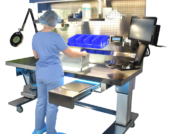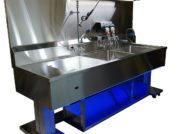
Three practical ways SPDs are using AI right now
In September we met with our Voice of the Customer council and followed up with breakout conversations to explore how sterile  processing leaders are applying AI today. The themes were pragmatic. Teams want tools that support standards, training, and staffing without disrupting existing workflows. Below are three use cases you can try without overhauling your systems or processes.
processing leaders are applying AI today. The themes were pragmatic. Teams want tools that support standards, training, and staffing without disrupting existing workflows. Below are three use cases you can try without overhauling your systems or processes.
We partnered with Gene Ricupito, Senior Project Manager, Sterile Processing at UCSF to identify practical applications of AI in sterile processing departments happening right now.
1) Your SPD’s “AI Librarian”
What it is
A department leader built a private GPT and loaded it with key standards and guidance so it can answer “Where does it say that?” with citations. In practice, the model can surface the exact sections to support common questions and provide language for policy reminders.
Why it helps
Faster and defensible answers reduce back and forth and reinforce policy adherence at the point of need.
How to pilot
Start with a limited library of validated policy and standards PDFs. Test with five common questions your team asks and confirm the citations before sharing.
2) AI for competency: turning quizzes into targeted training
What it is
Use AI to analyze CE outcomes and quiz results to spot patterns in what staff are learning well and where they miss. The goal is to identify knowledge gaps by topic and role, then adapt education accordingly.
Why it helps
Instead of broad refreshers for everyone, you can focus time on the few topics that repeatedly cause errors or rework.
How to pilot
Export recent quiz results, group misses by topic, and ask an AI tool to summarize patterns by role. Build one short refresher for the top two miss areas and recheck outcomes the following month.
3) From shift reports to staffing plans
What it is
Aggregate standardized shift reports that capture conditions in decontamination, washers, assembly, and sterilization. Feed those counts into an AI model to trend backlog, estimate FTE needs, and point to which shifts are under resourced. Start with weekdays and expand as your data grows.
Why it helps
Leaders get a clearer view of staffing deficiencies by shift and can tie staffing changes to throughput time from soil arrival to sterilizer output.
How to pilot
Pick five daily counts you can capture consistently, run a simple weekly trend, and compare predicted FTE needs to actual delays and overtime.
Conclusion
AI adoption in SPD does not need to be all or nothing. Start with a small library, a simple quiz review, and structured shift snapshots. Small wins build momentum, validate risk controls, and create data you can take to leadership. If you would like worksheets for the librarian pilot, competency analysis, or shift to staffing model, we can share templates to help you get started.
Interested in digging into more VOC content?
Four Practical AI Ideas SPD Leaders Can Pilot Now
About: Voice of the Customer Committee
The Voice of the Customer Committee is a panel of healthcare and instrument reprocessing professionals who have graciously donated their time to share their expertise and guidance on current challenges faced by the instrument reprocessing community. Through sharing their insights, experiences, and best practices, we have been given the opportunity to share these findings with our readership. We’d like to thank our VOC members for their outstanding input and insights, as well as their time! Thank you for your continued partnership, and all you do.





